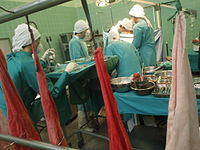
Photo from wikipedia
Recipients of the different types of transplantation are at high risk of infection. Nosocomial infections predominate in patients who have undergone haematopoietic stem cell transplantation during the early post-engraftment period… Click to show full abstract
Recipients of the different types of transplantation are at high risk of infection. Nosocomial infections predominate in patients who have undergone haematopoietic stem cell transplantation during the early post-engraftment period (30-100 days after the infusion); the incidence of infection is higher in graft-versus-host disease. Nodular lesions can appear in the lungs due to invasive fungal infection. A diffuse pattern is usually secondary to viral infection or P. jirovecii pneumonia. After the first 100 days a moderate risk of infection by conventional and opportunistic infections persists, such as late CMV infection. Advances in surgical techniques and the use of calcineurinics have reduced mortality from infections in recipients of solid organ transplantations. Nosocomial infections are common during the first month; opportunistic infections that are dependent on cellular immunity are more common between the first and the sixth month, from the sixth month the risk lowers and community-based infections similar to those of immunocompetent patients predominate.
Journal Title: Medicine
Year Published: 2018
Link to full text (if available)
Share on Social Media: Sign Up to like & get
recommendations!